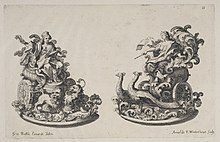

Trionfo (Italian: [triˈoɱfo]) is an Italian word meaning "triumph", also "triumphal procession", and a triumphal car or float in such a procession. The classical triumphal procession for victorious generals and Emperors known as the Roman Triumph was revived for "Entries" by rulers and similar occasions from the Early Renaissance in 14th and 15th-century Italy, and was a major type of festival, celebrated with great extravagance. The cars are shown as open-roofed, many clearly utilitarian four-wheeled carts dressed-up for the occasion. Others were two-wheeled chariots. In art, they might be pulled by all sorts of exotic animals.
Another specialized sense of the word was an elaborate sugar sculpture; these decorated tables on important occasions in the Renaissance and Baroque periods, especially in Italy and France. Eventually they were replaced by the silver surtout de table or porcelain centrepieces.[1]
The word may derive from a call of triumph during antique triumphal processions: "Io triumpe".
- ^ Strong, 216-223